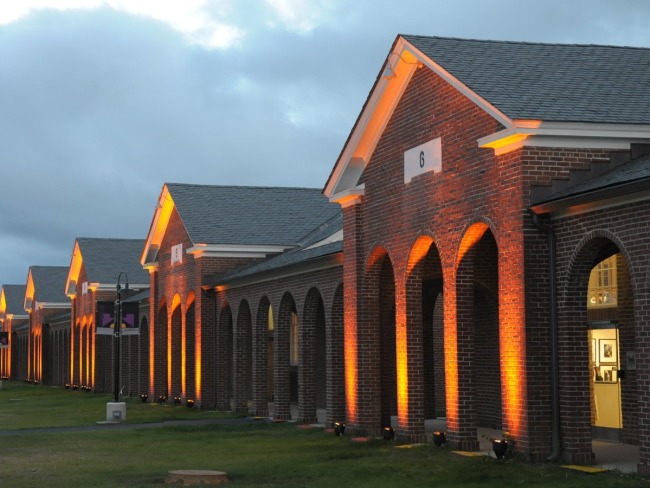Repurposing Correctional Facilities to Strengthen Communities
Twenty-one states partially closed or fully closed at least one correctional facility since 2000, resulting in a trend of prison repurposing in which old prisons are converted for community and commercial use.
Related to: Collateral Consequences, Incarceration

Executive Summary
Between 2000 and 2022, 21 states partially closed or fully closed at least one correctional facility and reduced correctional capacity in the United States by 81,444 prison beds, according to The Sentencing Project’s analysis of state records. This reduction in capacity reflects decades of work to reduce imprisonment rates in this country and growing public recognition that mass incarceration has not been a successful public safety strategy. Indeed, there is no evidence that closing prisons has any impact on public safety. But in a time of rising rates of serious crime, public officials face a question as to whether to continue the decarceration policies that led to both the capacity reduction and the reprioritization of resources to fund services and social supports that prevent criminal legal system contact.
Key to successful prison closure efforts has been the reuse of former correctional facilities for purposes beneficial to communities. A community reinvestment approach redirects funds states spend on prisons to rebuild the social capital and local infrastructure – quality schools, community centers, and healthcare facilities – in high-incarceration neighborhoods. Such an approach acknowledges the collateral impacts of mass incarceration on many overly policed neighborhoods where persons lived prior to their sentencing.
Repurposing closed prison facilities helps address how out of step the United States’ scale of incarceration is with the rest of the world and the unacceptable racial bias that dominates criminal legal practices. Below are examples of a few such projects:
- Michigan: The minimum-security Ojibway Correctional Facility planned reuse for business redevelopment.
- New York: Arthur Kill Correctional Facility, a closed medium-security prison, has been repurposed as a movie and television studio while the minimum-security Mid-Orange Correctional Facility is being reused as a business park.
- Tennessee: Brushy Mountain State Penitentiary, a former maximum-security prison, has been repurposed as a whisky distillery and campgrounds.
- Texas: The minimum-security Dawson State Jail planned reuse as a nonprofit office and community space.
- Virginia: The maximum-security Lorton Reformatory has been repurposed to a mixed-use development of housing and retail space.
Unfortunately, such projects are more of an exception than the norm. Lack of planning for the reuse of decommissioned prisons can lead to their continued use for incarceration purposes. Closed youth prisons have been transferred to adult prison systems while the end of county immigration detention contracts has led jail officials to contract with state prison agencies. At the time of this writing, a recent uptick in serious and violent crime could lead many public officials to return to the overly punitive practices that led to the construction of so many prisons and jails. This would be a grave mistake and sacrifice a valuable opportunity to put land and facilities to better use for the public good.
Indeed, this is the same mistake American leaders and the public made 50 years ago at the onset of the “mass incarceration” era. During the 1970s, U.S. lawmakers reacted to rising crime by ratcheting up punishment resulting in mass incarceration and building new correctional facilities to accommodate substantial growth in the nation’s prison population. Other Western democracies also experienced rises in crime during this period, yet they reduced imprisonment or sustained current incarceration levels. Their social and political culture did not result in punitive responses to crime rooted in harsh sentencing policies, rather they implemented preventive social policies to address the root causes of crime. American officials must consider the current scale of incarceration as they explore public safety solutions to address crime. Rather than relying on the failed policies of the mass incarceration era, US policymakers must fully fund crime prevention efforts led by community stakeholders through substantial investments at the local and state level. This report illustrates both the positive outcomes and challenges faced in accomplishing these goals through the closure and repurposing of correctional facilities.
Key Findings
Twenty-one states fully or partially closed prison facilities between 2000 and 2022. Prison capacity nationwide has been reduced by 81,444 beds.
Prison reuse planning is an emerging practice, including the establishment of New York’s Prison Reuse Commission, and the budgeting of public funding towards prison repurposing projects and related economic development.
Non-carceral prison reuse projects include community meeting space, mixed use real estate development, business parks, a whisky distillery and private event venue, and a movie studio.
Recommendations
Challenge Mass Incarceration
The circumstances surrounding prison closures vary from state to state and create challenges and opportunities. The rate of decarceration has been very modest in most states, and it remains vital to recalibrate sentencing policies to meaningfully address the nation’s scale of imprisonment.
Prison Reuse Planning
Prison population reductions create an opening to close prisons; in some communities there have been intentional discussions about repurposing prisons for non-correctional uses and political and financial support from federal, state, and local agencies. At least 21 states closed prisons between 2000 and 2022.
Prioritize Community Reinvestment
Community reinvestment acknowledges the collateral impacts of mass incarceration on many urban neighborhoods. A community reinvestment approach redirects some portion of the funds states now spend on prisons to rebuild the social capital in the neighborhoods where people lived prior to incarceration
Improve available data and documentation of prison reuse
Understanding best practices in prison reuse and closed correctional facilities demands more attention through data collection and research. Efforts to close prisons must emphasize reuse for non-carceral purposes. Advocates and policymakers alike should commit to repurposing closed prisons.


